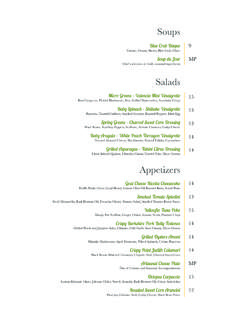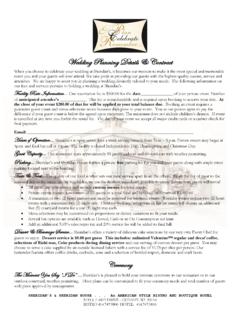Transcription of By Andrew Marton Special to DFW.com Posted 8:06am on ...
1 By Andrew Marton Special to Posted 8:06am on Wednesday, Sep. 14, 2011 The rumors and grumblings started almost from the moment Delaney's Irish Pub opened its doors in July 2010. A sprawling restaurant-bar with a wide-ranging food and beer menu , it was expected by many to be one of the most popular tenants to join the bustling West Seventh Street development in Fort Worth. The owners, Melissa and Stephen "Blue" Tate, had a proven track record with their first Delaney's, in McKinney. Many assumed that once it joined the marquee development, in an increasingly trendy section of a rapidly expanding city, it would be like planting the proverbial money tree. But Delaney's flamed out. Fast. Some blamed it on the cavernous size of the space, close to 9,000 square feet -- even when it was crowded, it felt sparse, even cold.
2 Some blamed it on the menu , a dizzying array of choices from Tex-Mex staples and Cajun food, to pub grub, at widely varying price points. "People don't go to an Irish pub to order $16 worth of possibly pretentious food," said one former general manager, Beau Greene. (The Tates did not respond to requests for comment.) On May 22, Delaney's shuttered its doors, a couple months shy of its first birthday. It's hardly the only high-profile restaurant casualty in recent months: In July, Mac's on 7th, in Montgomery Plaza, also closed down. Just east a few blocks on Seventh from Delaney's, So7 Bistro opened, closed, reopened with an altered concept and then closed again -- all in 12 months. In south Fort Worth, Hottub's Back Porch Grotto closed July 25, only seven months after it opened. Margherita, an ambitious Italian restaurant with a foodie vibe on the north side, lasted less than six months.
3 It has been a brutal reminder of the blood sport of opening a new restaurant: Even in a growing metropolitan area like Fort Worth, even when you have secured a platinum location, and even if you have a carefully refined concept, it can still be a life-savings gamble that never pays off. Yet at the same time, a parallel narrative has emerged: While Delaney's struggled to pay the rent, a number of restaurants in the same West Seventh development -- Fireside Pies andPatrizio among them -- have flourished, with the kind of weekend-night waits that prompt nightclubs to put out the velvet ropes. Right next to So7 Bistro, Chuy's, the Austin-based Mexican food chain, opened its doors and proved an instantaneous blockbuster. According to some estimates, it's pulling in upward of $100,000 per week. Just a few steps away from the now defunct Mac's on 7th, Gloria's, the Dallas-based Salvadoran restaurant, is typically overflowing with happy, paying customers.
4 So what separates the runaway successes from the heartbreaking failures? Why does a place like Delaney's go belly up when, just down the street, a similar restaurant-bar concept like The Pour House is booming? There is no fool-proof formula, especially in Fort Worth. You have to start with high volume, top quality food and a great location -- one where the rent doesn't swallow your profits. A distinctive chef and food philosophy help, too. And impeccable service and affordable prices could earn you repeat business -- and a fighting chance. "The restaurant that gets a diner who comes in once a month to make it there twice a month is the one that will last," says Russell Kirkpatrick, president of the Tarrant County Restaurant Association and assistant general manager at Reata. The bottom line is that only about 50 percent of new restaurants survive past 18 months, and despite those odds, more and more people seem willing to take the risk.
5 "There will always be that maverick restaurant that is willing to roll the dice and come [to Fort Worth]," says Kirkpatrick. And in Cowtown, you have to play by the house rules. "Don't be pretentious and do not assume for one minute that these people are hillbillies and not well-traveled," says Jeffrey Yarbrough, CEO of Big Ink, a restaurant consulting firm that works with Sushi Axiom, the Pour House and Lambert's Steaks, Seafood and Whiskey. "They have an impeccable palate for art, music and want to experience new things. There is a real humility in Fort Worth, and you can't come in to Fort Worth beating your chest, saying how cool you are. "You'll just look like a chump," he says. A Fort Worth attitude In the last three years, a cluster of swashbuckling restaurateurs, many riding in from Dallas, have set up a western Metroplex outpost in Fort Worth.
6 And who can blame them, given the whopping population increase in Fort Worth (and Tarrant County in general) over the last decade, even if much of that growth has been in suburban areas. But the challenges to opening a successful restaurant here start with paying for a prized location, and then determining an affordable price point for food. "I feel that in Fort Worth anyway, a $21 lobster mac-and-cheese starter is just going to alienate a lot of diners," says restaurant consultant Shawn Horne. Appetizers in the $6-$9 range and $9-$20 entrees seem to be what the market will bear, he says. For any new restaurant, the most pivotal financial consideration is often the cost for a prime location. And no stretch has been more of a hotbed of restaurant growth than the Seventh Street corridor -- extending from just west of the Trinity River bridge through the So7 and Montgomery Plaza complexes, into the development on West Seventh Street.
7 The estimated $40 per square foot in the West 7th development is $6-$8 higher than what one might pay in Sundance Square. And the nearby Montgomery Plaza and So7 development reportedly charge as much as $10-$15 less per square foot. Contrast those prices with the relatively affordable $15-$25 per square foot that, according to Richard King, co-owner of Ellerbe Fine Foods, is the average cost along the Magnolia Avenue restaurant corridor, or the $13 per square foot that Jon Bonnell, executive chef-owner ofBonnell's Fine Texas Cuisine pays in southwest Fort Worth. "I can be as busy as some of the restaurants in the West Seventh development," says Bonnell. "And still remain a highly profitable destination location because, among other things, I'm not staring at a big, ugly rent check every month." Some of the heftier leases in West 7th can cost an estimated $15,000-$30,000 a month.
8 For many restaurants, what's more difficult to calculate than lease numbers, however, is what the average Fort Worth restaurant customer wants. "I do feel that the Fort Worth guest can get a little turned off by any restaurant that places a certain emphasis on glitz, glamour and flash," Kirkpatrick says. "While Fort Worth folks are very approachable and friendly, they fully expect the same out of the service from their restaurant," adds Horne, the developer and consultant who is looking into a project in the Montgomery Plaza complex. "What they don't tolerate -- and this is where some of the newcomers to the scene may have made a mistake -- is a lot of big-city swagger." The slippery slope But even if a restaurant answers the requisite startup questions of location and service, it can still fail.
9 "I truly had a really good lunch and brunch business, and I had some great regulars, but I could never develop the dinner business I needed," says Mike McMahan, owner and managing partner of Mac's on 7th. "At dinner, it became more of a bar area and all those bars over here take up so much parking that I couldn't develop the easy dinner business I needed." The downturn in the economy, in McMahan's mind, didn't help either. His price point -- an average of $10-$30 for dinner entrees -- may have been a bit too steep for these recessionary times. And the Montgomery Plaza complex never attracted the high-end retail that he had hoped would bring more deep-pocketed customers to Mac's, which still has locations in Colleyville and Arlington. "The area simply didn't develop like I thought it would," laments McMahan.
10 "Even with the landlord helping me out, I could never develop enough sales to make a Actually sales had been increasing during my first two years and then, in the last six months, they started dropping by 10 percent. It was just going in the wrong direction and I couldn't afford to put any more money into it." On the heels of the Mac's on 7th demise, many Fort Worth restaurant proprietors have engaged in a parlor game of speculating why several new arrivals, like Mac's, may be wobbling financially. "I actually think there may be more restaurant casualties down the road," says Eric Tschetter, owner of the Pour House, "because Fort Worth is actually not growing quite as fast as can accommodate all the new restaurants and bars that want to come here. "Fewer people are going out with less disposable income to spend, and none of us is doing the business we all thought we would do," he adds.






![[ the tucci’s philosophy ]](/cache/preview/e/c/c/c/3/9/2/c/thumb-eccc392c4fe5f7bd7cbc543ae5fb0f72.jpg)